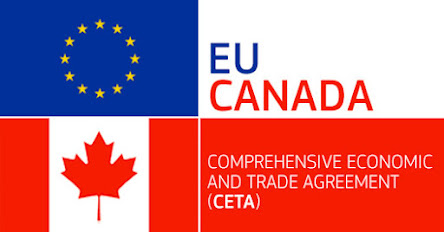Business strategy is heavily influenced by regulation,
especially when trying to diversify activities abroad. However, the
ever-changing environment forces shifts in strategy and decision making.
A key institution
The World trade Organization, an extension of the General Agreements on Tariffs and Trade of 1947, based on the Most Favored Nation Clause, meaning that all tariffs that are applied to the nation that is most favored by the agreement are also applied to every other nation. Giving birth to a world order in which no advantage is given to nations on the basis of their influence. This system was the norm until the 1990s. Businesses could trade with any nation without having to worry about changes in tariffs and non-tariff trade barriers. The WTO is the symbol of multilateralism and free trade.
A Shift
Since 1990, however, a metamorphosis occurred. Due to the
WTO’s wish to expand their jurisdiction to critical and strategic sectors,
member states started to make use of unilateral retortions to prevent this
completely putting the WTO to a standstill. The recent conflict between the
European Union and the United States over Airbus and Boeing, for example, is
representative of these policies, both regions are trying to subsidize their
own civil aviation industry to gain a competitive advantage and gain a monopoly
over the market. More recently, Donald Trump tried to prevent the use of the
dispute settlement body of the WTO by claiming it was undermining the United
States’ sovereignty. This weakening of the WTO is also vector of a bigger
change, the regionalization of the world. The fading institution that was the
symbol of multilateralism is slowly being replaced by larger regions that establish
trade agreements between each other. For example, the Comprehensive Economic and
Trade Agreement between the EU and Canada will completely change the structure
of trade throughout the world. One might even say “bring about a new world
order”.
Regulation is a crucial factor to take into a count when
trying to diversify company activities abroad. The sizable change in regulation
brought by the change of the structure of trade, makes it increasingly more
difficult gathering information regarding the different tariff systems.
Companies with vast capital and cash flows can easily access this information
by carrying out extensive market research, on the other hand, small and
middle-sized enterprises trying to expand their activities are faced with the
increasing complexity of this system. This creates a setting in which the
latter are threatened by the first without any means to retaliate. The market
inequalities are becoming more apparent. Larger companies will see this shift
as new opportunities to expand to foreign markets without the threat of smaller
companies getting in their way. Moreover, some sectors will be affected in many
aspects. The bovine industry in Europe for example, due to the CETA will see
its market flooded by Canadian meat injected with growth hormones (which is illegal
to produce inside the EU) rendering European businesses less competitive.
A change in strategy.
Although this appears like a threat to SMEs, anyone can use
the regulatory environment as an opportunity. Businesses have to adapt and find
new strategies, in order to maximize their efforts exporting their activities.
The decision-making process has to be adjusted. Paying closer attention to the
regulations seems to be a given in such circumstances. To do so, thorough market
research has to be carried out. On one hand, it leads to soaring costs, but on the
other, it limits the entry of other competitors to these foreign markets by creating
non-tariff barriers. Once a market is entered, reduced negotiation power from
other market players make business growth opportunities easier to seize due to
the decreased competition in that environment.
In conclusion, the shift from a multilateral world centered
around the WTO and its most favoured nation clause, to a plurilateral one, with megaregions
making advantageous trade agreements on a case by case basis brought new
challenges that private enterprise has to tackle in order to internationalize their activities. From this increased complexity of markets arise threats and
opportunities that have to be learned to deal with and make the best out of.
Tobias.S
Sources
Rainelli M., 2007, l’Organisation Mondiale du Commerce, La découverte. 128p ➢ Guillochon B., 2001, Le protectionnisme, La découverte. 128p
Canal-Forgues E., 2003, Le règlement des différends à l’OMC, Bruylant. 164p
Wilkinson R., 2000, Multilateralism and the World Trade Organisation, Routledge. 180p
Sébastien J., « Désaccords commerciaux internationaux : Au-delà de Trump », Politique étrangère N° 1/2019, Institut français des relations internationales. pp. 57-69.
Jean-Marc S., Les guerres commerciales de Trump : haro sur le multilatéralisme, Politique étrangère 2018/4, Institut français des relations internationales. pp. 87- 101
CEPII, 2020, L’économie mondiale 2021, La découverte. 127p
Organisation Mondiale du Commerce [Online], Historique du système de règlement des différends de l’OMC, 2020 [ 03 october 2020] https://www.wto.org/french/tratop_f/dispu_f/disp_settlement_cbt_f/ c2s1p1_f.htm
Organisation Mondiale du Commerce [online], Communautés européennes et certains États membres — Mesures affectant le commerce des aéronefs civils gros porteurs, 2020 [03 october 2020] https://www.wto.org/french/tratop_f/dispu_f/cases_f/ds316_f.htm
Les Echos [Online], Airbus-Boeing : retour sur un conflit de plus de quinze ans, 2020 [03 october 2020] https://www.lesechos.fr/industrie-services/airdefense/airbus-boeing-retour-sur-un-conflit-de-plus-de-quinze-ans1137290
L’Usine Nouvelle [Online], L'Europe pourra taxer des produits américains en représailles aux subventions accordées à Boeing, 2020 [ 03 october2020]https://www.usinenouvelle.com/editorial/l-europepourra-taxer-des-produits-americains-en-represailles-auxsubventions-accordees-a-boeing.N1010784



Comments
Post a Comment